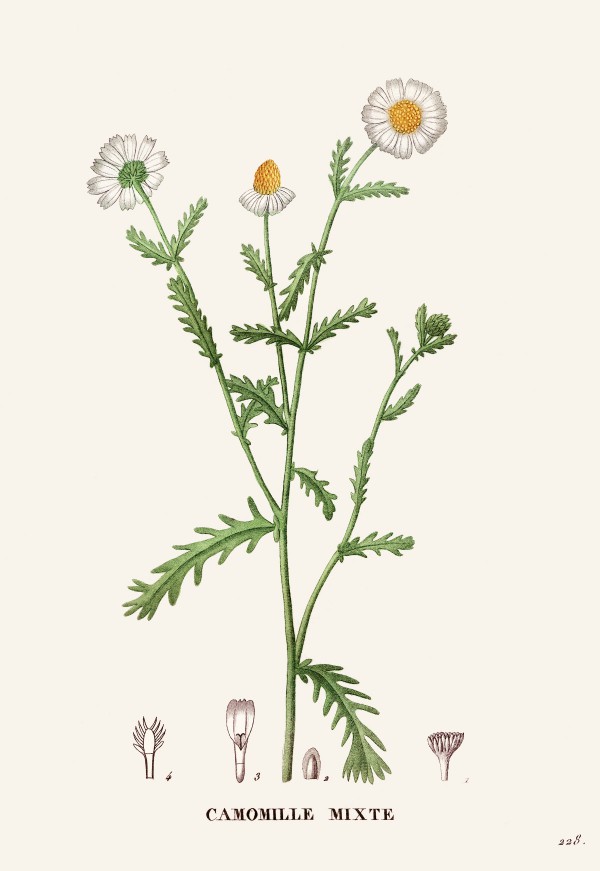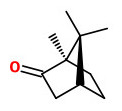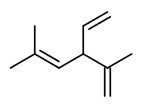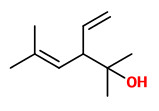Cladanthus mixtus (L.) Chevall. - syn. Chamaemelum mixtum(L.) All.; Anthemis mixta L.; Ormenis mixta (L.) Dumort.; Ormenis multicaulis Braun-Blanq. & Maire - Asteraceae
Moroccan chamomile, Marokkanische Kamille
Annual herb, 10-40cm high, pubescent, odoriferous. „Leaves in rosette, alternated, green bright. Cauline leaves with very large foliar axil, pinnatipartite with entire or serrate segment mucron and hairs decreasing in height throughout base. Hair intensity increases with development; flower yellow tubulous with white ligule in capitulum. flowers with pointed hairy plicate palea. Involucre of bracts scarious margin. Fruits : achenes very small (1mm) yellowish.“ http://www2.dijon.inra.fr/hyppa/hyppa-a/antmi_ah.htm
Essential oil from the aerial parts (with sweet fruity, balsamic, herbaceous notes) is used in aroma therapy (not to be confused with oil of German chamomile).
„Air-dried aerial parts of Ormenis mixta (L.) Dumort. ssp. multicaulis collected from two different regions of Morocco (Kénitra and Salé) were hydrodistilled yielding averagely 0.4 % essential oil. The oils were qualitatively similar and characterized by an important percentage of irregular monoterpenic alcohols. The major oil component of Ormenis mixta whole plants from Kénitra was santolina alcohol (24.1-47.6 %) which is associated with yomogi alcohol (1.3-2.2 %), artemesia alcohol (1.2-2.4 %) with corresponding acetates, in smaller quantity. While the major oil components of Ormenis mixta whole plants from Salé were santolina alcohol (44.7-55.1 %), artemesia alcohol (4.1-5.1 %) and yomogi alcohol (1.6-3.0 %). In addition, the essential oils contained sesquiterpenes mainly represented by germacrene D (3.2 and 4.9 %), epi-α-muurolol (5.5 and 5.7 %) and α-cadinol (5.4 and 5.2 %), respectively in samples from Kénitra and Salé.
The effect of plant organs on the oil Production and its Chemical composition were also examined. We noted that the flower essential oil was rich in santolina alcohol (40.2 %).“
[Chemical Composition of the Essential Oils of Moroccan Ormenis mixta (L.) Dumort. ssp. Multicaulis, S. Zrira, C. Menut, J.M. Bessiere, B. Benjilalii, Journal of Essential Oil Bearing Plants, Vol.10 (5), 2007, 378-385]
„The chemical variability of the essential oils isolated from Moroccan chamomile [Cladanthus mixtus (L.) Chevall.] full flowering aerial parts, was evaluated. C. mixtus populations were collected from nine regions in Morocco: Benguerir, Bouznika, Chefchaouane, Kenitra, Meknes, Oujda, Settat, Sidi Alal Ibahraoui and Tamesna. The essential oils were isolated by hydrodistillation and analysed by gas chromatography and gas chromatography-mass spectrometry. The yields of the essential oils ranged between 0.1% and 0.8% (v/d.w.). Only five of the nine essential oil samples analysed showed good correlation after agglomerative cluster analysis based on the chemical composition of the essential oils. These samples (Benguerir, Kenitra, Settat, Meknes and Tamesna) were characterized by the dominance of camphor (14-27%), β-myrcene (3-17%) and santolina triene (3-15%). All these and Chefchaouane essential oils showed a blue colour, whereas Oujda, Bouznika and Sidi Alal Ibahraoui essential oils were yellow. β-Myrcene (3-17%), trans-β-farnesene (18%) and 2-tridecanone (16%) dominated the Chefchaouane essential oil, whereas trans-β-farnesene (43%) was the main component in the Oujda essential oil. 2-Methyl-2-trans-butenyl methacrylate (34%) dominated sample Bouznika, while santolina alcohol and 1,8-cineole (17% and 12%, respectively) in the Sidi Alal Ibahraoui essential oil. The variability of Moroccan chamomile essential oil may reflect negatively upon its quality, biological activity and commercial value, thus harvests from the wild population should be avoided.“
[Yield and chemical composition of the essential oil of Moroccan chamomile [Cladanthus mixtus (L.) Chevall.] growing wild at different sites in Morocco., Elouaddari, A., El Amrani, A., Eddine, J.J., Correia, A.I.D., Barroso, J.G., Pedro, L.G., Figueiredo, A.C., Flavour and Fragrance Journal, Vol.28(6), 2013, 360-366]
Oil of C.mixtus grown in Temara (western Morocco) contained camphor (21%), β-myrcene (13%), santolinatriene (10%), santolina alcohol (5%), α-pinene (4%), yomogi alcohol (4%), camphinelone (3%), 1,8-cineol (3%), cis-α-bisabolene (3%), (E)-β-farnesene (3%), thymol (2%) and caryophyllene acetate (2%).
[Moroccan traditional fragrance based essential oils: Preparation, composition and chemical identification., Ainane, T., M’hammed Elkouali, A.A., Talbi, M., Der Pharma Chemica, Vol.6(6), 2014, 84-89]
http://derpharmachemica.com/vol6-iss6/DPC-2014-6-6-84-89.pdf

Cladanthus mixtus as Anthemis mixta
Jaume Saint-Hilaire, J. H. (1830) La flore et la pomone françaises. 3. Band. Eigenverlag, Paris. Tafel 228
https://commons.wikimedia.org/wiki/File:Cladanthus_mixtus.jpg



